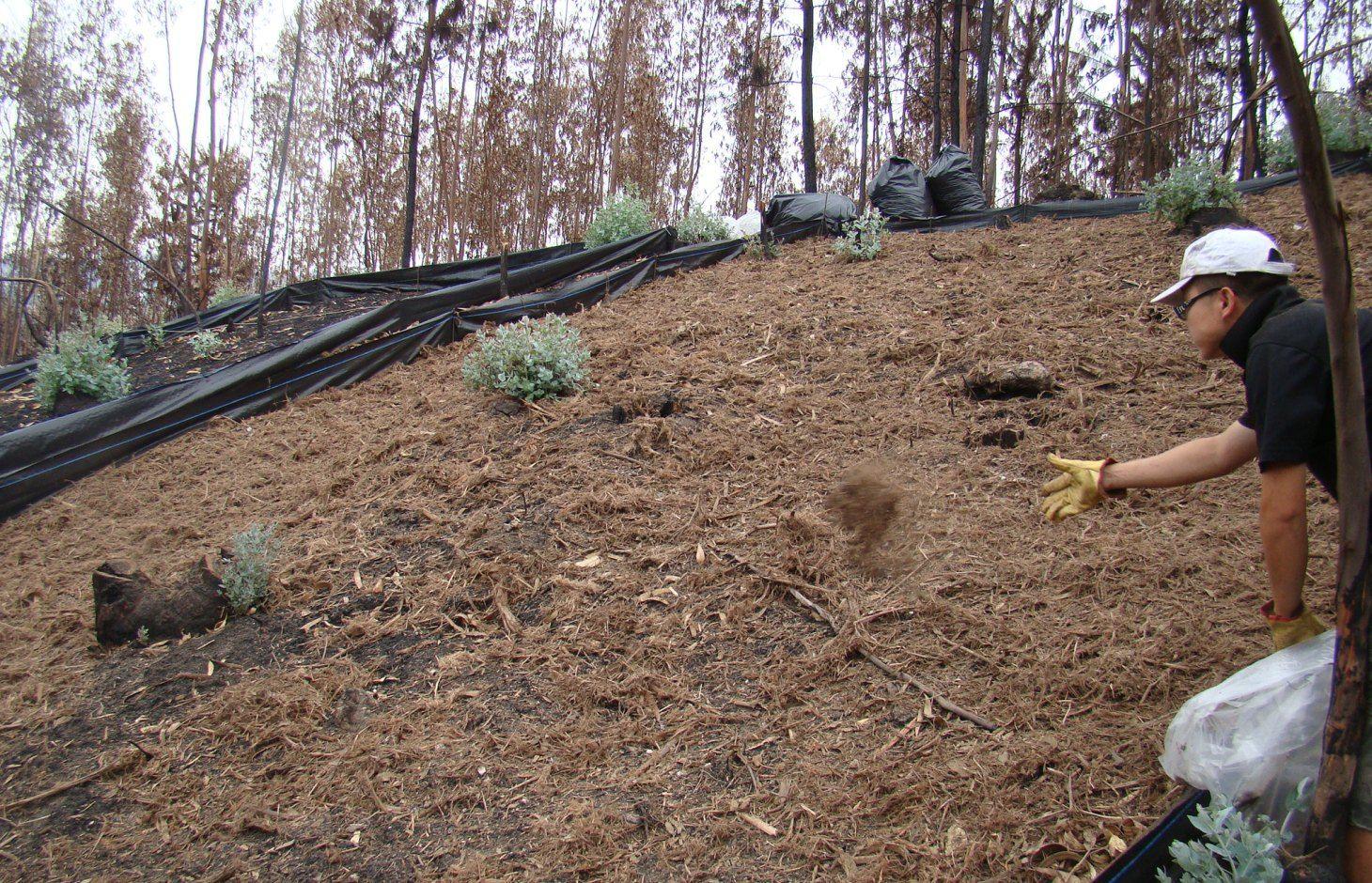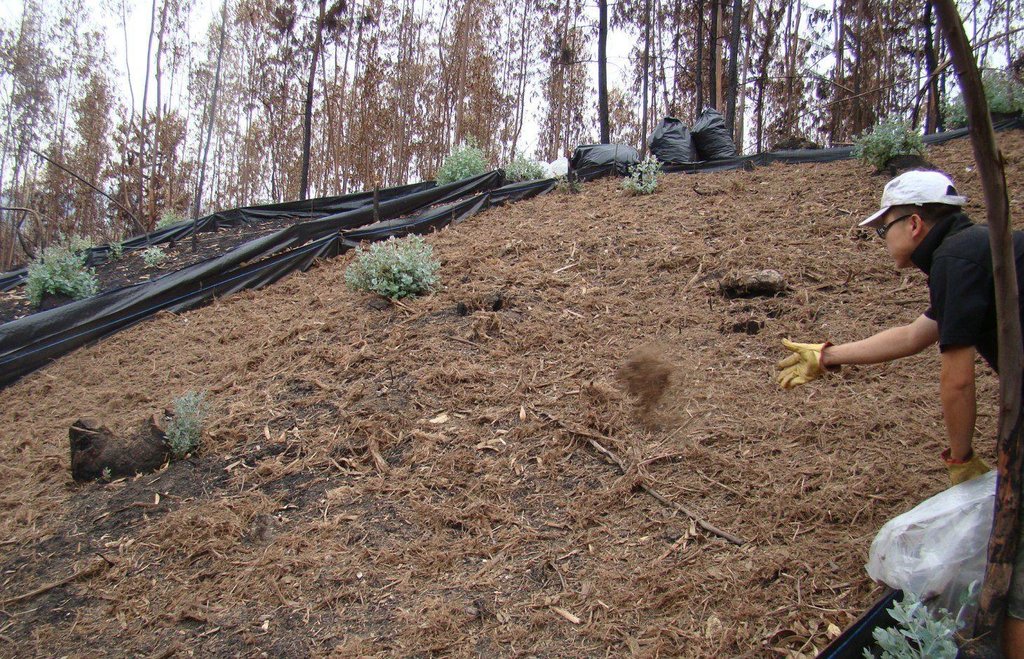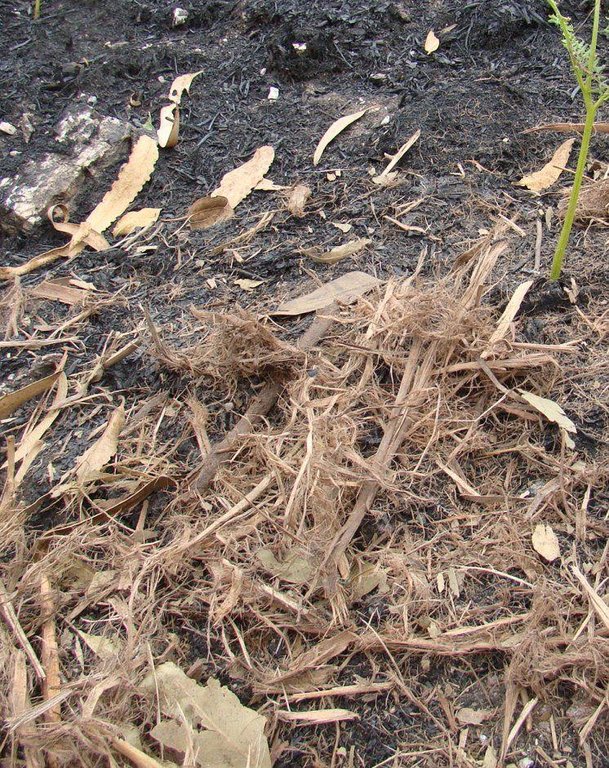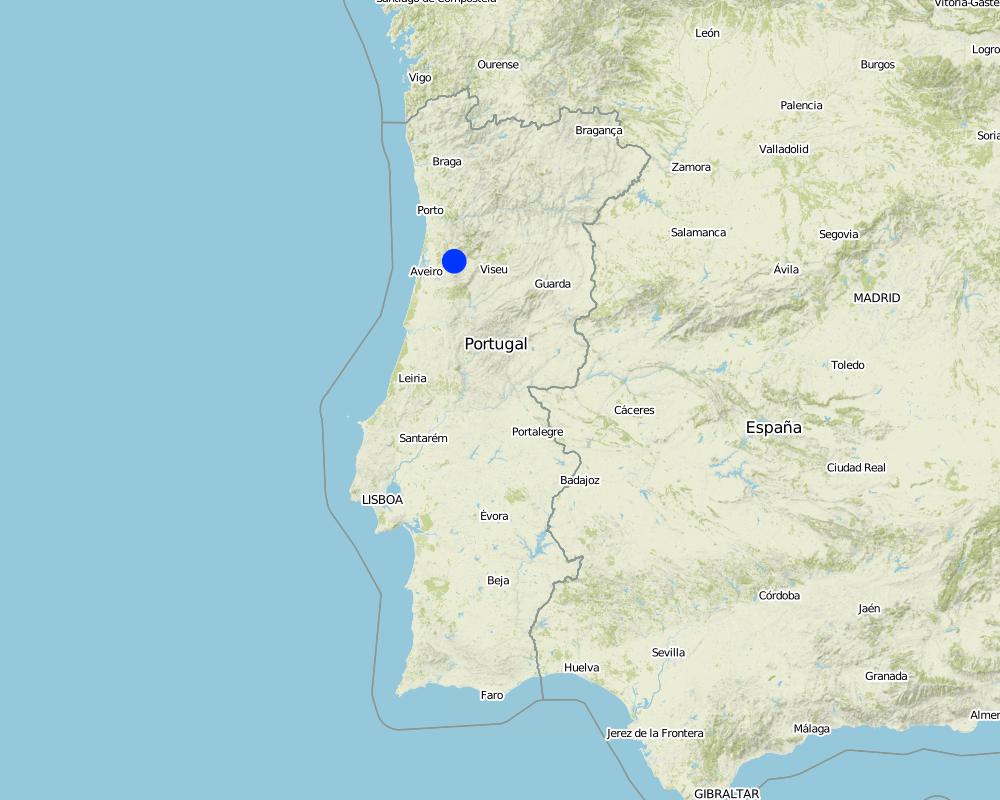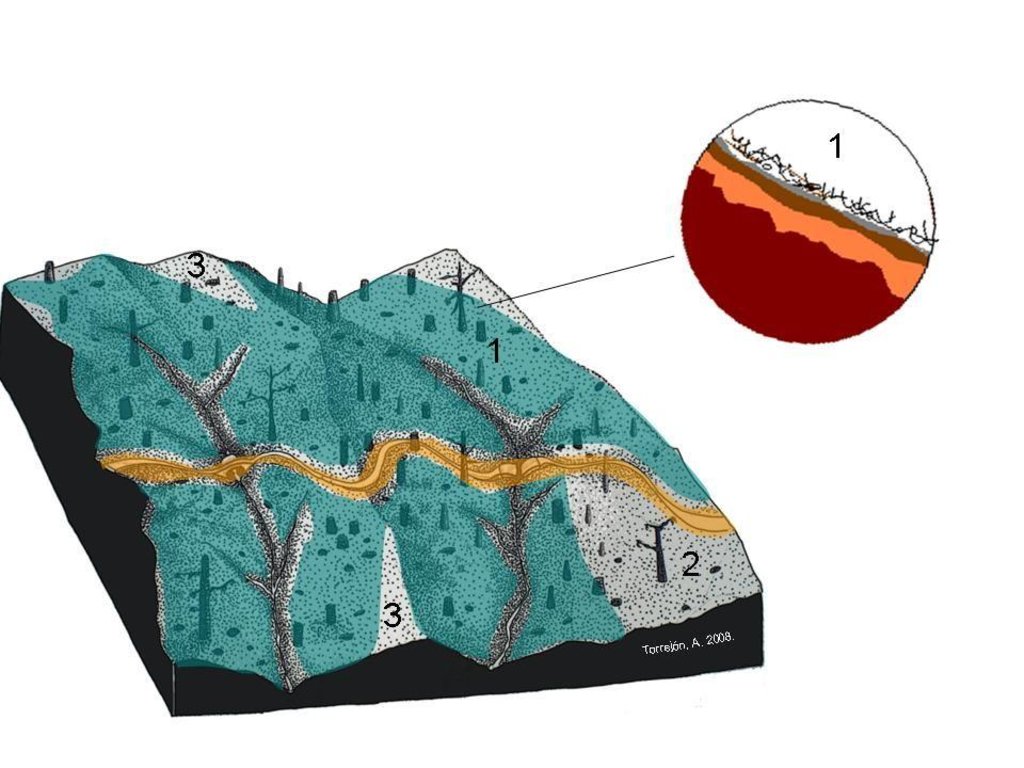Post-fire Forest Residue Mulch [Portugal]
- Creation:
- Update:
- Compiler: Sergio Prats Alegre Prats
- Editor: –
- Reviewers: Fabian Ottiger, Alexandra Gavilano
acolchoado, aplicação de restos vegetais
technologies_1186 - Portugal
View sections
Expand all Collapse all1. General information
1.2 Contact details of resource persons and institutions involved in the assessment and documentation of the Technology
SLM specialist:
Keizer Jan Jacob
Universidade de Aveiro-CESAM
Portugal
SLM specialist:
Name of project which facilitated the documentation/ evaluation of the Technology (if relevant)
Preventing and Remediating degradation of soils in Europe through Land Care (EU-RECARE )Name of project which facilitated the documentation/ evaluation of the Technology (if relevant)
Catastrophic shifts in drylands (EU-CASCADE)Name of the institution(s) which facilitated the documentation/ evaluation of the Technology (if relevant)
University of Aveiro (University of Aveiro) - Portugal1.3 Conditions regarding the use of data documented through WOCAT
The compiler and key resource person(s) accept the conditions regarding the use of data documented through WOCAT:
Yes
2. Description of the SLM Technology
2.1 Short description of the Technology
Definition of the Technology:
Forest residue mulch is spread immediately after a wildfire in order to prevent soil erosion and reduce overland flow.
2.2 Detailed description of the Technology
Description:
In two areas of eucalypt plantations affected by wildfires in central Portugal in 2007 and 2010, the research team of the University of Aveiro set up two experiments in order to test the effect of forest residue mulching as a soil erosion mitigation technique. Forest residues such as chopped eucalypt bark mulch was spread over a group of erosion plots, and was compared to an untreated group of plots.
The mulching was applied at ratios of 8.7 and 10.8 Mg ha-1 provided an initial ground cover of 70 to 80%, and was found to reduce post-fire runoff by 40-50% and soil erosion by 85-90%, respectively.
Purpose of the Technology: The increase in ground cover will decrease post-fire soil erosion by reducing raindrop impact over the ashes and bare soil, and decrease the runoff amount by increasing water surface storage, decreasing runoff velocity, and increase infiltration.
Ideally, post-fire mulching must be carried out immediately after the fire, in order to prevent that the first autumn rainfall events fall over the bare and unprotected burnt soils. It is intended for places in which burnt severity was moderate to high and where there are important values at risk, such as water reservoirs, populations, industries, human and wild life.
Establishment / maintenance activities and inputs: The chopped bark mulch was obtained at a depot 20 km from the burnt area, where eucalypt logs are debarked and then transported to a paper pulp factory. The bark is chopped into fibers and are typically transported to a biomass energy plant. We used these 10–15 cm wide 2–5 cm long bark fibers as the source for our mulching experiment. The chopped bark mulch decays very slowly (around 20% less ground cover per year) which was very useful in cases of low re-growth of natural vegetation.
Natural / human environment: The eucalypt trees in the region are typically planted as monocultures for paper pulp production, and harvested every 7-14 years. The landscape reflects a long history of intense land management, with a mosaic of (semi-)natural and man-made agricultural and afforested lands. Since the 1980´s, however, wildfires have increased dramatically in frequency and extent, aided by a general warming and drying trend but driven primarily by socio-economic changes.
2.3 Photos of the Technology
2.5 Country/ region/ locations where the Technology has been applied and which are covered by this assessment
Country:
Portugal
Region/ State/ Province:
Portugal/Beira Litoral
Further specification of location:
Sever do vouga/ Pessegueiro do Vouga, Ermida
Specify the spread of the Technology:
- evenly spread over an area
If precise area is not known, indicate approximate area covered:
- < 0.1 km2 (10 ha)
Comments:
Total area covered by the SLM Technology is 1.0E-5 m2.
The experiment was carried out in grous of small bounded plots of 0.25, 16 and 100 m2.
Map
×2.6 Date of implementation
If precise year is not known, indicate approximate date:
- less than 10 years ago (recently)
2.7 Introduction of the Technology
Specify how the Technology was introduced:
- during experiments/ research
Comments (type of project, etc.):
The first experiment was carried out in 2007.
3. Classification of the SLM Technology
3.2 Current land use type(s) where the Technology is applied

Forest/ woodlands
- Tree plantation, afforestation
Type of tree:
- Eucalyptus species
Products and services:
- Timber
- Fuelwood
Comments:
Major land use problems (compiler’s opinion): Increased runoff and soil erosion, resulting in a decrease of on-site fertility and derived off-site effects such as loss of water quality, reservoirs water volume storage, higher risk of flooding and human beings damage.
Major land use problems (land users’ perception): Loss of wood resources and productivity.
Plantation forestry: eucalypt are logged and left to regrow from stumps each 7-10 years
Forest products and services: timber, fuelwood
Number of growing seasons per year: 1
3.5 SLM group to which the Technology belongs
- improved ground/ vegetation cover
3.6 SLM measures comprising the Technology

agronomic measures
- A1: Vegetation/ soil cover
Comments:
Main measures: agronomic measures
Type of agronomic measures: mulching
3.7 Main types of land degradation addressed by the Technology

soil erosion by water
- Wt: loss of topsoil/ surface erosion
- Wo: offsite degradation effects

chemical soil deterioration
- Cn: fertility decline and reduced organic matter content (not caused by erosion)

water degradation
- Hs: change in quantity of surface water
- Hp: decline of surface water quality
Comments:
Main type of degradation addressed: Wt: loss of topsoil / surface erosion, Hs: change in quantity of surface water, Hp: decline of surface water quality
Secondary types of degradation addressed: Wo: offsite degradation effects, Cn: fertility decline and reduced organic matter content
Main causes of degradation: crop management (annual, perennial, tree/shrub) (Eucalypt monocultures are prone to suffer wildfires), deforestation / removal of natural vegetation (incl. forest fires), disturbance of water cycle (infiltration / runoff) (Increased runoff is observed after wildfires), Heavy / extreme rainfall (intensity/amounts) (Burnt areas are very sensitive to high intensity events), other natural causes (avalanches, volcanic eruptions, mud flows, highly susceptible natural resources, extreme topography, etc.) specify (Sediment deposition can decrease the storage volume of reservoirs.)
Secondary causes of degradation: floods (Overland flow can be extremely high after forest fires), inputs and infrastructure: (roads, markets, distribution of water points, other, …) (Roads concentrated the runoff and are greatly degraded.)
3.8 Prevention, reduction, or restoration of land degradation
Specify the goal of the Technology with regard to land degradation:
- prevent land degradation
- reduce land degradation
Comments:
Main goals: prevention of land degradation, mitigation / reduction of land degradation
4. Technical specifications, implementation activities, inputs, and costs
4.1 Technical drawing of the Technology
Technical specifications (related to technical drawing):
Forest residue mulch is spread as homogeneous as possible over steep areas (steeper than 15º) burnt at high fire severity (represented in green and 1). Other areas which are flat (2) and burnt at low severity or only partially burnt (3) must be avoided.
Location: Ermida. Sever do Vouga/ Portugal
Date: 15 9 2010
Technical knowledge required for field staff / advisors: low (forest residue mulching is highly effective in all situations, but applications using short fibres mulching as well as low intensity burning should be avoided.)
Technical knowledge required for land users: low
Main technical functions: control of raindrop splash, control of dispersed runoff: retain / trap, control of concentrated runoff: retain / trap, control of concentrated runoff: impede / retard, control of concentrated runoff: drain / divert, improvement of ground cover, improvement of water quality, buffering / filtering water, sediment retention / trapping, sediment harvesting
Secondary technical functions: control of dispersed runoff: impede / retard, reduction of slope angle, increase of surface roughness, increase in organic matter, increase of infiltration, increase / maintain water stored in soil, increase of groundwater level / recharge of groundwater
Mulching
Material/ species: chopped bark, cork, stems, leaves, straw/eucalypt, pine, oaks, shrubs
Quantity/ density: 2-10t/ha
Remarks: material with low density (straw) need less weight for achieving the final goal: 70% ground cover.
Author:
Departamento de Ambiente e Ordenamento. Universidade de Aveiro.
4.2 General information regarding the calculation of inputs and costs
other/ national currency (specify):
Euro
If relevant, indicate exchange rate from USD to local currency (e.g. 1 USD = 79.9 Brazilian Real): 1 USD =:
0.78
Indicate average wage cost of hired labour per day:
64.00
4.3 Establishment activities
| Activity | Timing (season) | |
|---|---|---|
| 1. | Labour | |
| 2. | Transportation (small truck for carrying persons and material) | |
| 3. | Eucalypt chopped bark mulch | |
| 4. | Others |
4.4 Costs and inputs needed for establishment
| Specify input | Unit | Quantity | Costs per Unit | Total costs per input | % of costs borne by land users | |
|---|---|---|---|---|---|---|
| Labour | Labour | ha | 1.0 | 192.0 | 192.0 | 100.0 |
| Equipment | Machine use | ha | 1.0 | 51.2 | 51.2 | 100.0 |
| Other | Forest residue mulch | ha | 1.0 | 307.6 | 307.6 | 100.0 |
| Other | Others | ha | 1.0 | 64.1 | 64.1 | 100.0 |
| Total costs for establishment of the Technology | 614.9 | |||||
| Total costs for establishment of the Technology in USD | 788.33 | |||||
Comments:
Duration of establishment phase: 1 month(s)
4.6 Costs and inputs needed for maintenance/ recurrent activities (per year)
Comments:
The prices were determined in winter 2012 for central Portugal. It is intended that mulch is applied only once, and thus maintenance is not needed. In other regions other forest residues can have a higher availability. Straw, needles, deciduous leaves or chopped shrubs are lighter compared to eucalypt chopped bark, slash stems or wood chips, and thus, can be easier to apply and transport. However, the lighter the material, the easier it can be blown away in windy areas.
4.7 Most important factors affecting the costs
Describe the most determinate factors affecting the costs:
Accessibility and steepness will raise the costs, but selecting forest residues with lower densities as well as applying them in horizontal strips along the slope can reduce the application rates and the costs.
For large and inaccessible areas some researchers indicated that helicopters can reduce the costs.
5. Natural and human environment
5.1 Climate
Annual rainfall
- < 250 mm
- 251-500 mm
- 501-750 mm
- 751-1,000 mm
- 1,001-1,500 mm
- 1,501-2,000 mm
- 2,001-3,000 mm
- 3,001-4,000 mm
- > 4,000 mm
Agro-climatic zone
- humid
- sub-humid
Thermal climate class: subtropics
Thermal climate class: temperate
5.2 Topography
Slopes on average:
- flat (0-2%)
- gentle (3-5%)
- moderate (6-10%)
- rolling (11-15%)
- hilly (16-30%)
- steep (31-60%)
- very steep (>60%)
Landforms:
- plateau/plains
- ridges
- mountain slopes
- hill slopes
- footslopes
- valley floors
Altitudinal zone:
- 0-100 m a.s.l.
- 101-500 m a.s.l.
- 501-1,000 m a.s.l.
- 1,001-1,500 m a.s.l.
- 1,501-2,000 m a.s.l.
- 2,001-2,500 m a.s.l.
- 2,501-3,000 m a.s.l.
- 3,001-4,000 m a.s.l.
- > 4,000 m a.s.l.
Comments and further specifications on topography:
Altitudinal zone: 101-500 m a.s.l. (300m)
5.3 Soils
Soil depth on average:
- very shallow (0-20 cm)
- shallow (21-50 cm)
- moderately deep (51-80 cm)
- deep (81-120 cm)
- very deep (> 120 cm)
Soil texture (topsoil):
- coarse/ light (sandy)
- medium (loamy, silty)
Topsoil organic matter:
- high (>3%)
If available, attach full soil description or specify the available information, e.g. soil type, soil PH/ acidity, Cation Exchange Capacity, nitrogen, salinity etc.
Topsoil organic matter is high (Around 10 % between 0 to 5 cm of soil depth)
Soil fertility is high-medium
Soil drainage/infiltration is medium (Dependent on the soil water repellence cycles, characteristics of eucalypt and pine plantations on the area.)
Soil water storage capacity is medium
5.4 Water availability and quality
Ground water table:
5-50 m
Availability of surface water:
good
Water quality (untreated):
good drinking water
5.5 Biodiversity
Species diversity:
- medium
5.6 Characteristics of land users applying the Technology
Market orientation of production system:
- mixed (subsistence/ commercial)
- commercial/ market
Off-farm income:
- less than 10% of all income
Relative level of wealth:
- poor
- average
Individuals or groups:
- employee (company, government)
Gender:
- women
- men
Indicate other relevant characteristics of the land users:
Land users applying the Technology are mainly common / average land users
Population density: 50-100 persons/km2
Annual population growth: negative
50% of the land users are average wealthy.
40% of the land users are poor.
10% of the land users are poor.
5.7 Average area of land used by land users applying the Technology
- < 0.5 ha
- 0.5-1 ha
- 1-2 ha
- 2-5 ha
- 5-15 ha
- 15-50 ha
- 50-100 ha
- 100-500 ha
- 500-1,000 ha
- 1,000-10,000 ha
- > 10,000 ha
Is this considered small-, medium- or large-scale (referring to local context)?
- small-scale
5.8 Land ownership, land use rights, and water use rights
Land ownership:
- communal/ village
Land use rights:
- communal (organized)
- individual
Water use rights:
- open access (unorganized)
5.9 Access to services and infrastructure
health:
- poor
- moderate
- good
education:
- poor
- moderate
- good
technical assistance:
- poor
- moderate
- good
employment (e.g. off-farm):
- poor
- moderate
- good
markets:
- poor
- moderate
- good
energy:
- poor
- moderate
- good
roads and transport:
- poor
- moderate
- good
drinking water and sanitation:
- poor
- moderate
- good
financial services:
- poor
- moderate
- good
6. Impacts and concluding statements
6.1 On-site impacts the Technology has shown
Socio-economic impacts
Water availability and quality
water availability for livestock
irrigation water availability
demand for irrigation water
Income and costs
expenses on agricultural inputs
Comments/ specify:
Eucalypt chopped bark mulch increases expenses if not funded by the Government
Socio-cultural impacts
SLM/ land degradation knowledge
conflict mitigation
Comments/ specify:
Less damage to off-site neighbouring properties
Improved livelihoods and human well-being
Comments/ specify:
Public awareness of the technology is very limited. It is necessary to show it to landowners and stakeholders and increase dissemination.
Ecological impacts
Water cycle/ runoff
water quality
surface runoff
groundwater table/ aquifer
evaporation
Soil
soil moisture
soil cover
soil loss
soil organic matter/ below ground C
Biodiversity: vegetation, animals
animal diversity
beneficial species
Other ecological impacts
Hazard towards adverse events
6.2 Off-site impacts the Technology has shown
water availability
downstream flooding
downstream siltation
Comments/ specify:
If applied in large areas
groundwater/ river pollution
buffering/ filtering capacity
wind transported sediments
damage on neighbours' fields
damage on public/ private infrastructure
Comments/ specify:
If applied in large areas upslope
6.3 Exposure and sensitivity of the Technology to gradual climate change and climate-related extremes/ disasters (as perceived by land users)
Gradual climate change
Gradual climate change
| Season | increase or decrease | How does the Technology cope with it? | |
|---|---|---|---|
| annual temperature | increase | well |
Climate-related extremes (disasters)
Meteorological disasters
| How does the Technology cope with it? | |
|---|---|
| local rainstorm | well |
| local windstorm | well |
Climatological disasters
| How does the Technology cope with it? | |
|---|---|
| drought | well |
Hydrological disasters
| How does the Technology cope with it? | |
|---|---|
| general (river) flood | not well |
Other climate-related consequences
Other climate-related consequences
| How does the Technology cope with it? | |
|---|---|
| reduced growing period | not known |
6.4 Cost-benefit analysis
How do the benefits compare with the establishment costs (from land users’ perspective)?
Short-term returns:
positive
Long-term returns:
neutral/ balanced
How do the benefits compare with the maintenance/ recurrent costs (from land users' perspective)?
Short-term returns:
slightly positive
Long-term returns:
slightly positive
6.5 Adoption of the Technology
Comments:
Comments on acceptance with external material support: The technology has been tested by scientific researchers and it is very effective, but not broadly implemented.
Comments on spontaneous adoption: The technology has been tested by scientific researchers researchers and it is very effective, but not broadly implemented.
There is no trend towards spontaneous adoption of the Technology
6.7 Strengths/ advantages/ opportunities of the Technology
| Strengths/ advantages/ opportunities in the land user’s view |
|---|
| It will prevent sediment movement and accumulation over roads and downslope properties |
| Strengths/ advantages/ opportunities in the compiler’s or other key resource person’s view |
|---|
|
It is a technology very easy to apply, with low failure possibilities and a strong soil erosion control How can they be sustained / enhanced? Some researchers found better performance by grinding the mulch and selecting only the longest fibres. |
| The material is readily available (residues from the main forest specie affected by the wildfire) |
6.8 Weaknesses/ disadvantages/ risks of the Technology and ways of overcoming them
| Weaknesses/ disadvantages/ risks in the land user’s view | How can they be overcome? |
|---|---|
| The costs are not very high, but enough to discourage the landowners to cover the expenses. | Look for Government funding, educate land owners about soil erosion conservation techniques. |
| Weaknesses/ disadvantages/ risks in the compiler’s or other key resource person’s view | How can they be overcome? |
|---|---|
| When applying high density mulches the application labour requirements and costs will be higher | Distribute the mulch in strips, use lighter mulches, grind to remove the fine fibres or maybe try to reduce the application rate. It is also possible to use in-situ chopping tree machines or to use aerial application methods, such as helicopters to reduce the application costs. |
7. References and links
7.1 Methods/ sources of information
7.2 References to available publications
Title, author, year, ISBN:
Prats S. A., Macdonald L.H., Monteiro M.S.V., Ferreira A.J.D., Coelho C.O.A., Keizer J.J.,2012. Effectiveness of forest residue mulching in reducing post-fire runoff and erosionin a pine and a eucalypt plantation in north-central Portugal. Geoderma 191, 115-124.
Available from where? Costs?
Internet
Title, author, year, ISBN:
Shakesby R.A., Boakes D.J., Coelho C.O.A., Gonçalves A.J.B., Walsh R.P.D., 1996. Limitingthe soil degradational impacts of wildfire in pine and eucalyptus forests in Portugal.Applied Geography 16, 337-335.
Available from where? Costs?
Internet
Title, author, year, ISBN:
Robichaud, P.R., Lewis, S.A., Ashmun, L.E., Wagenbrenner, J.W., Brown, R.E., 2013a.Postfire mulching for runoff and erosion mitigation Part I: Effectiveness at reducinghillslope erosion rates. Catena 105, 75–92.
Available from where? Costs?
Internet
Links and modules
Expand all Collapse allLinks
No links
Modules
No modules


